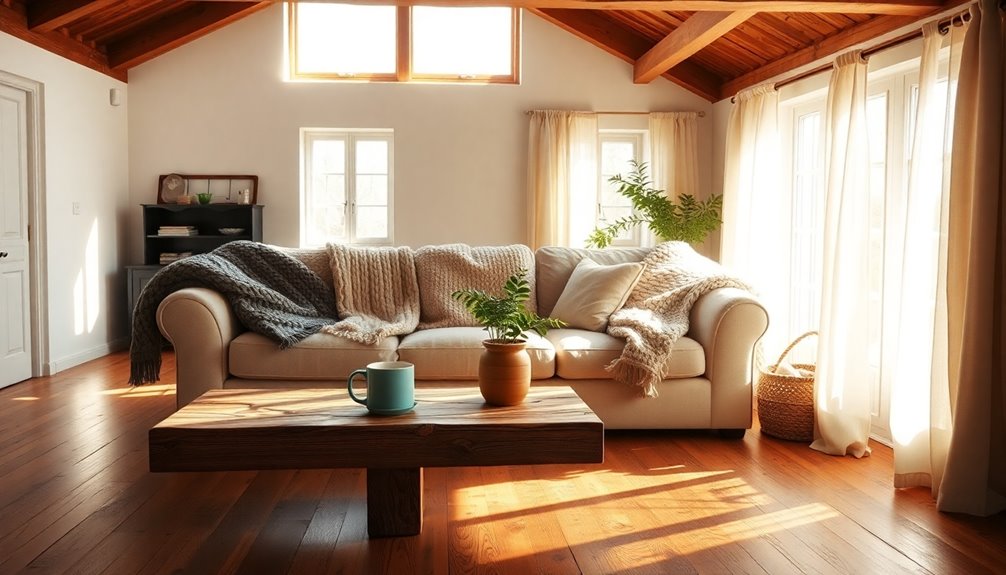Blending furniture styles is all about balance and cohesion. You'll want to guarantee different pieces share equal visual weight and complement each other in scale. Mixing textures—like soft fabrics with sleek metals—adds depth and interest. Sticking to a cohesive color palette can unify disparate styles, while introducing unique decor items adds a personal touch. Each room may call for specific strategies, like pairing mismatched sofas in the living room for a cozy vibe. By mastering these principles, you'll create inviting spaces that resonate with your personality. There's much more to explore about blending styles effectively.
Key Takeaways
- Achieve harmony by ensuring different furniture styles carry equal visual weight and complement each other in scale and proportion.
- Incorporate contrasts, such as soft textures against hard surfaces, to create visual interest and depth in your space.
- Use a cohesive color palette and common materials to unify disparate furniture styles for a more inviting atmosphere.
- Mix various textures, like leather and fabric, to enhance the comfort and richness of the overall design.
- Personalize your space with unique decor items to reflect your individuality while maintaining a dynamic yet unified environment.
Principles of Mixing Styles

When it comes to mixing furniture styles, striking the right balance is key. You'll want to guarantee that different styles carry equal visual weight, creating a harmonious look throughout your space. To achieve this, consider incorporating contrast, which adds visual interest.
Balancing curves with straight lines, or soft textures with hard surfaces, can enhance the overall aesthetic and keep your design engaging.
Cohesion is equally important when mixing styles. Unify your disparate pieces through common elements, like a shared color palette or similar materials. This helps tie your design together, making it feel intentional rather than chaotic.
Don't forget about scale; the sizes of mixed furniture should complement one another to create an inviting atmosphere.
Lastly, prioritize functionality along with aesthetics. Practical design choices enhance usability without sacrificing visual appeal. Additionally, layering textures and colors can create a cozy atmosphere that invites comfort and warmth into your space.
Room-Specific Strategies

When it comes to blending styles, each room presents unique opportunities.
In your living room, consider mixing mismatched sofas for added texture, while in the bedroom, distinct bedside tables can really elevate the space. Additionally, incorporating natural elements into your decor can enhance the tranquility of the room. For instance, using aesthetic hooks can not only serve a functional purpose but also add visual interest to your walls. Furthermore, integrating traditional healing practices through decor can create a meaningful connection to cultural heritage. To create a warm atmosphere, consider incorporating neutral color palettes that are characteristic of modern farmhouse style.
Let's explore some effective strategies tailored to each area of your home.
Living Room Approaches
Creating a living room that reflects your unique personality involves moving away from traditional matching furniture sets. Instead, focus on mixing furniture styles to enhance individuality. Incorporate different textures, colors, and shapes to create a cozy, inviting atmosphere that truly represents you.
Here are three effective living room approaches to ponder:
- Mismatched Sofas: Embrace sofas that differ in style and color. This creates a rich visual interest and comfort, contributing to an eclectic vibe.
- Black and White Palette: Utilize a combination of black and white furniture for a modern aesthetic. Layer in various rugs and pillows to add warmth and character to the space.
- Patterns and Bold Colors: Experiment with accessories featuring bold colors and patterns. Make certain they complement the overall design, adding personality while maintaining a harmonious look.
Bedroom Design Tips
Blending different furniture styles in your bedroom can transform it into a personal sanctuary that showcases your unique taste. Instead of sticking to a matching set, focus on mixing and matching pieces that resonate with your vision.
Pair a rustic headboard with contemporary bedding to create an eclectic yet harmonious look. This combination adds depth and character to your space. Incorporating natural materials like wood and stone can further enhance the farmhouse aesthetic, as environmentally-friendly choices promote sustainability in design. Using vintage patterns in textiles can also add a charming touch to the overall decor.
When it comes to bedside tables, think outside the box. You might combine a modern lamp with a vintage table, infusing individuality and charm. Bold color pops against a neutral base can also make striking visual statements while keeping the atmosphere serene.
Don't forget about the accent chair! A well-placed chair in a contrasting style can serve as a focal point and provide extra seating.
Be mindful of balance in your design; limit the number of accent pieces to a few impactful items that align with the overall aesthetic. This approach guarantees that your bedroom remains inviting and cohesive. Additionally, incorporating rustic elements can enhance the warmth and charm of your space.
Practical Mixing Tips

When mixing furniture styles, focusing on color cohesion can make a significant difference in your space. You'll want to choose a balanced color palette that ties everything together while mixing textures to create visual interest. Additionally, incorporating items with personalized touches can enhance the overall aesthetic and make the space feel uniquely yours. To achieve a relaxed vibe, consider using natural materials like jute and driftwood to complement your mixed styles. Incorporating open spaces within your design can also help to create a harmonious flow between different furniture styles. Moreover, utilizing vertical storage solutions can free up floor space, allowing your mixed furniture to shine without feeling crowded.
Color Cohesion Strategies
Often, achieving color cohesion in a mixed furniture style setting requires a thoughtful approach to your palette. Start by selecting a cohesive color palette that includes two neutral shades and two accent colors. This strategy creates visual harmony and prevents the space from feeling overwhelming.
To enhance your design, consider these practical tips:
- Utilize neutrals: Use neutral colors as a unifying backdrop. They allow vibrant accent colors to shine, drawing attention to specific pieces of matching furniture.
- Incorporate patterns: Patterns can tie together different design styles. Verify these patterns complement each other to avoid clashes.
- Mind the lighting: Be aware that lighting affects color perception. Test how your chosen colors interact under different lighting conditions to maintain cohesion.
- Consider integrating sustainable materials for furniture pieces, as they often feature a distinctive aesthetic that can enhance your mixed style approach.
Texture Variety Importance
Incorporating a variety of textures into your furniture arrangement can truly elevate your space, adding depth and interest. Mixing different textures, like pairing smooth leather with soft fabric or rough wood with polished metal, creates a dynamic environment that invites engagement.
Consider layering textures in your furniture pieces; for instance, draping a faux fur throw over a sleek sofa or using contrasting patterned cushions on a solid chair can foster a cozy, eclectic atmosphere.
Remember, balance is key. Larger furniture pieces should display a dominant texture, while smaller accessories can introduce complementary textures for a cohesive look. This variety not only enhances aesthetic appeal but also invites tactile experiences, making your space feel more lived-in and personal.
Experiment with different combinations to find what resonates with your style. Don't shy away from bold choices—mixing different textures can turn a mundane room into a work of art.
Ultimately, the goal is to create a layered, inviting environment that reflects your personality and encourages comfort. Embrace the beauty of texture variety, and watch your space transform!
Understanding Furniture Styles

Furniture styles serve as the foundation for creating a cohesive and inviting space in your home. Each style offers a unique perspective on design, influenced by materials, shapes, and historical context. By understanding these styles, you can make informed choices that resonate with your personal taste. Some popular furniture styles include mid-century modern, traditional, industrial, and bohemian. Each style has its own set of characteristics that can help you achieve the desired look and feel in your home. When it comes to creating a timeless look, consider investing in quality pieces that will stand the test of time. Some tips for timeless furniture include choosing classic shapes, opting for neutral colors, and prioritizing comfort and functionality. By following these guidelines, you can create a space that feels stylish and inviting for years to come.
Here are a few common furniture styles:
- Modern: Characterized by clean lines and minimalist design, often using materials like metal and glass.
- Traditional: Emphasizes classic details and rich woods, reflecting historical craftsmanship.
- Eclectic: A mix of various styles, allowing for creativity and personal expression in your interior design.
Recognizing your preferences is essential when selecting furniture styles. It helps in achieving a satisfying and cohesive outcome.
Familiarity with different styles not only enhances your ability to mix pieces effectively but also supports the creation of unique interiors that tell your story. Mixing styles can lead to delightful surprises and a distinctive character in your space. Additionally, understanding how to clean leather sofas ensures that your eclectic mix remains well-maintained and inviting.
Embrace the journey of blending furniture styles, and let your home reflect your personality and lifestyle.
Textures and Colors

When blending furniture styles, textures and colors play a pivotal role in achieving a harmonious look. Start with a cohesive color palette; neutrals can serve as a unifying backdrop, while accent colors enhance specific pieces.
Layering different textures adds depth to your space. Think about combining smooth leather with rough wood for a dynamic feel. This contrast creates visual interest and invites touch.
Don't shy away from mixing materials like glass and metal. These elements can highlight differences in style but should maintain consistency in quality for a sophisticated look.
Lighting is also key—warm lighting can enhance warm colors, making them feel inviting, while cooler lighting can make cool colors pop.
Incorporating patterns through textiles, such as rugs and cushions, can effectively tie together various furniture styles. This layering of textures and colors will create a cohesive blend that feels thoughtfully designed.
Additionally, the ability to celebrate individual styles fosters a unique atmosphere that reflects personal taste and creates a welcoming environment.
Remember, the goal is to create a space that feels both dynamic and unified, where each element complements the others rather than competing for attention.
Design Trends and Insights

Blending different furniture styles can set the stage for exploring the latest design trends shaping modern interiors.
As you immerse yourself in these trends, you'll notice a strong emphasis on sustainability. Eco-friendly materials are gaining popularity, reflecting a growing environmental consciousness in your interior spaces. Many designers prioritize sustainable materials to ensure their projects align with eco-friendly practices, similar to how Montessori Toys emphasize the use of natural materials and non-toxic production methods to promote safety and environmental responsibility.
Minimalism remains a favorite, prioritizing simplicity and functionality to create harmonious living environments. You'll find that reducing clutter not only enhances aesthetic appeal but also promotes a sense of calm.
Additionally, bold colors are making a comeback, allowing you to infuse vibrancy into your spaces. Embrace striking designs that energize your home and showcase your personality.
Here are three key insights to reflect on:
- Sustainable Materials: Choose eco-friendly options that contribute to a healthier planet.
- Personalization: Design your space to reflect your lifestyle and values, moving away from generic aesthetics.
- Bold Colors: Don't shy away from vibrant hues; they can transform any room into a dynamic environment.
Furthermore, the integration of modern technology into rustic aesthetics is becoming increasingly popular in contemporary farmhouse decor.
Additional Resources and Tools

Explore a wealth of resources and tools designed to help you master the art of mixing furniture styles. One invaluable resource is Universal Furniture's To the Trade program, which offers expert design support for professionals looking to blend various styles effectively. By tapping into this program, you can access a guide to mixing that simplifies the process.
Stay updated with the latest trends through Architectural Digest, which provides ongoing coverage of innovative ideas for creating spaces that reflect your unique taste. Their insights can inspire you to experiment with different furniture styles in your home and also highlight the importance of community collaboration in design, which can significantly enhance the creative process. Understanding lighting design can also help enhance the overall ambiance of your mixed furniture styles. Additionally, consider how the principles of tropical architecture can inspire your furniture choices, creating a seamless transition between indoor and outdoor living areas.
Finally, take advantage of design platforms that offer original content and extensive archives. These serve as valuable references for inspiration and guidance in mixing furniture styles.
By employing design thinking principles, you can enhance your approach to blending styles, ensuring that your space resonates with both creativity and functionality.
With these resources at your fingertips, you'll find it easier to create a cohesive and inviting space that truly reflects your personality.
Frequently Asked Questions
Is It OK to Mix Different Styles of Furniture?
Did you know that nearly 70% of designers believe mixing furniture styles adds personality to a space?
So yes, it's definitely okay to mix different styles of furniture! You can create a unique environment that reflects your taste.
Just establish a common color palette to unify pieces, balance textures, and avoid overcrowding. Incorporating a focal point can also anchor the design, making your mixed styles feel intentional and cohesive.
Embrace your creativity!
What Is the 2/3 Rule for Furniture?
The 2/3 rule for furniture suggests you should fill about two-thirds of your room with furniture, leaving one-third open for balance and flow.
This guideline helps prevent overcrowding, making sure you've got enough space for movement and accessibility.
When you apply this rule, think about your furniture's scale in relation to the room size.
Adapting it to your personal style and needs can create a comfortable and inviting atmosphere.
How Do You Mix Different Styles in a Design?
You might think mixing styles will lead to chaos, but it can actually create a stunning, personalized space.
Start by establishing a base style, like modern or traditional, to ground your design. Use a cohesive color palette to harmonize diverse pieces and guarantee balance in scale and weight.
Don't forget to mix textures for added depth, and limit accent pieces to impactful items that unify the overall look without overwhelming your room.
What Is the Mixing of Different Styles Called?
The mixing of different styles in design is called eclectic design. You embrace various aesthetics to create a unique space that reflects your personality.
This approach allows you to combine pieces from different periods, styles, and textures, resulting in a rich visual narrative.
To achieve balance and cohesion, you can focus on a central theme or color palette that ties everything together, ensuring your eclectic design feels harmonious and inviting.









